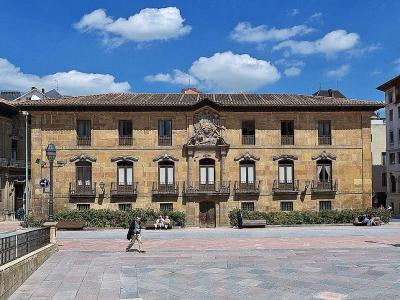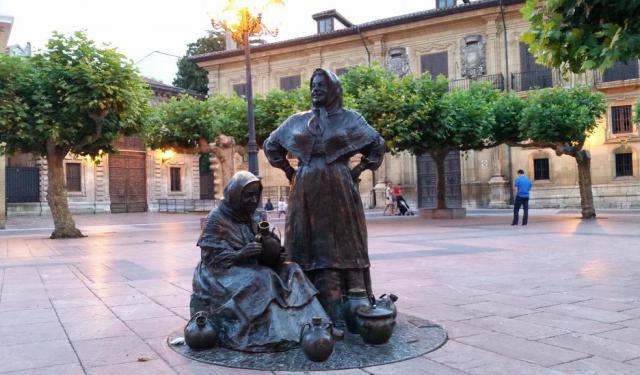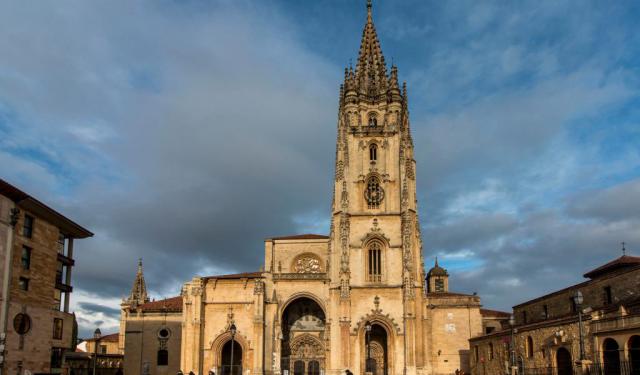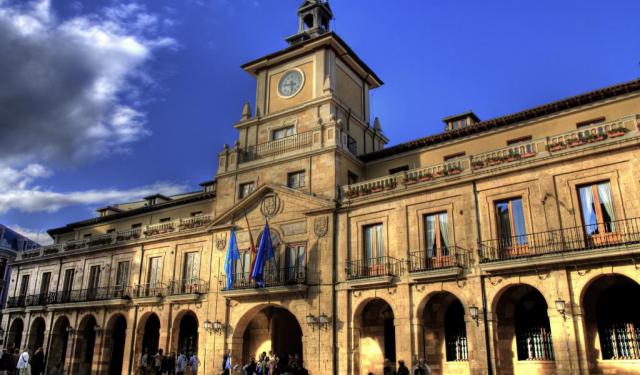
Palacio de Valdecarzana-Heredia (Valdecarzana-Heredia Palace), Oviedo
The Valdecarzana-Heredia palace, a large palatial complex in Plaza de la Catedral, was built between 1627 and 1629 by Don Diego de Miranda. It was designed as the seat for the Miranda family, one of the greatest lineages in the Principality of Asturias. As such, the palace occupies a privileged location, near the Cathedral, attesting to the family's dignified social status and economic and political power.
The house is a pure example of Baroque style. It follows the model of free-standing palaces with a cubic floor plan structured around a large central patio. The three-storey structure is very sober in appearance and consists of simple lines, creating a firm impression of stability.
Its bare western façade, of solid stonework, was once flanked by two four-storey towers, of which only one remains today. Here, you can see the Miranda family coat of arms with the crown of the Marquis of Valdecarzana. The eastern façade of the palace also features elaborate stonework and has, on its second floor, the coat of arms of the Miranda and Ponce de León. The second floor windows are accentuated with wrought iron balconies.
At the end of the 18th century, the Heredia family, the new owners of the palace, reformed the property, endowing its courtyard with the current southern façade, and demolishing the tower on that side along with the garden. Here, over the entrance, you can see the Heredia coat of arms, featuring Hercules fighting the Nemean lion, along with a figurehead featuring the inscription in the form of a diadem, dated 1774.
The seven balconies that open onto the main patio have a lowered arch and present artistic and molded finishes, with scallops and masks.
The house is a pure example of Baroque style. It follows the model of free-standing palaces with a cubic floor plan structured around a large central patio. The three-storey structure is very sober in appearance and consists of simple lines, creating a firm impression of stability.
Its bare western façade, of solid stonework, was once flanked by two four-storey towers, of which only one remains today. Here, you can see the Miranda family coat of arms with the crown of the Marquis of Valdecarzana. The eastern façade of the palace also features elaborate stonework and has, on its second floor, the coat of arms of the Miranda and Ponce de León. The second floor windows are accentuated with wrought iron balconies.
At the end of the 18th century, the Heredia family, the new owners of the palace, reformed the property, endowing its courtyard with the current southern façade, and demolishing the tower on that side along with the garden. Here, over the entrance, you can see the Heredia coat of arms, featuring Hercules fighting the Nemean lion, along with a figurehead featuring the inscription in the form of a diadem, dated 1774.
The seven balconies that open onto the main patio have a lowered arch and present artistic and molded finishes, with scallops and masks.
Want to visit this sight? Check out these Self-Guided Walking Tours in Oviedo. Alternatively, you can download the mobile app "GPSmyCity: Walks in 1K+ Cities" from Apple App Store or Google Play Store. The app turns your mobile device to a personal tour guide and it works offline, so no data plan is needed when traveling abroad.
Palacio de Valdecarzana-Heredia (Valdecarzana-Heredia Palace) on Map
Sight Name: Palacio de Valdecarzana-Heredia (Valdecarzana-Heredia Palace)
Sight Location: Oviedo, Spain (See walking tours in Oviedo)
Sight Type: Attraction/Landmark
Guide(s) Containing This Sight:
Sight Location: Oviedo, Spain (See walking tours in Oviedo)
Sight Type: Attraction/Landmark
Guide(s) Containing This Sight:
Walking Tours in Oviedo, Spain
Create Your Own Walk in Oviedo
Creating your own self-guided walk in Oviedo is easy and fun. Choose the city attractions that you want to see and a walk route map will be created just for you. You can even set your hotel as the start point of the walk.
Oviedo Public Art Walking Tour
Public art adds a great deal of vibrancy and character to the cityscape of Oviedo, Spain, reflecting, among other things, its contemporary spirit. From the bustling Plaza Trascorrales to the serene Plaza Porlier De Oviedo, numerous sculptures have long become an integral part of the neighborhood, captivating passers-by in their numbers.
In Plaza Trascorrales, sculptures like The Fishwife and... view more
Tour Duration: 3 Hour(s)
Travel Distance: 3.0 Km or 1.9 Miles
In Plaza Trascorrales, sculptures like The Fishwife and... view more
Tour Duration: 3 Hour(s)
Travel Distance: 3.0 Km or 1.9 Miles
Oviedo Introduction Walking Tour
The Kingdom of Asturias began in 720, with the Visigothic revolt against Muslim rule led by the nobleman Pelagius. At that time, the city of Oviedo did not exist. Two monks, Maximo and Fromestano, founded the city in 761. They built a small church for Saint Vincent on a bare hillside, and from this seed, Oviedo grew.
After Pelagius died in 737, King Alfonso I founded a dynasty in Oviedo that... view more
Tour Duration: 1 Hour(s)
Travel Distance: 1.8 Km or 1.1 Miles
After Pelagius died in 737, King Alfonso I founded a dynasty in Oviedo that... view more
Tour Duration: 1 Hour(s)
Travel Distance: 1.8 Km or 1.1 Miles
Oviedo Historic Architecture
The north Spanish region of Asturias and particularly its capital city, Oviedo, have long been noted for their unique architecture. The medieval part of town, whose ancient walls are still largely intact, contains some truly priceless relics. Among them is a well called La Foncalada, a fascinating example of an effective hydraulic system, dating back to the first half of the 9th century, based on... view more
Tour Duration: 2 Hour(s)
Travel Distance: 2.7 Km or 1.7 Miles
Tour Duration: 2 Hour(s)
Travel Distance: 2.7 Km or 1.7 Miles



